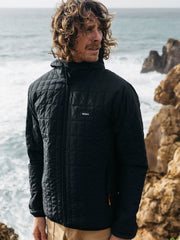Ambassador Dr Easkey Britton's latest book, Ebb & Flow, is an exploration of water’s power to heal us, inspire us and offer us spiritual meaning. Giving us a sneak peek ahead of its April release to mark International Women's Day, this excerpt looks at our connection to water and how it is slowly being restored through education and community.
Ebb and Flow: Restoring Our Water Connection
07.03.23
3 min read
Words & Images by Dr Easkey Britton
Early the next morning, the heavy rain and sea mist that rolled in from the Atlantic during the night had lifted, revealing once again the indented coastline and wavy outline of the Connemara mountain range across the water. The tide was in full flood, filling the small, sheltered bay of Portdoon, and the island’s resident population of 50 tripled in size as families arrived on the ferry. All those who were either born on the island or are the descendants of those who lived there come back for a week every July for what is known locally as “Swim Week”. It coincides with World Drowning Prevention Day – drowning is the world’s third leading cause of unintentional-injury deaths.
We have a physical memory in our bodies of what it means to be home in water. When we are born into the world we all carry birth trauma, that separation from the sacred water that may only be healed by a return to that watery world. It is why water offers us what feels like an intimate invitation yet can also feel like a place of loss and forgetting. To connect with water properly, we need to feel confident when we are in and around it.
For generations in Ireland the sea was “taboo” for anything like recreation or play. Instead, it was a place of risk, danger and violence, as well as an essential lifeline for sustenance, livelihoods and transport (or escape from poverty). Tragic drowning incidents are etched into plaques and memorials all along the coastline, especially the storm-battered west, instilling a legacy of fear – that it was better not to go near the sea at all rather than try to learn to swim. Today, the benefits of water confidence and knowing how to swim are well known.
The water temperature hovered around 14°C (57°F). Girls in their mid teens were leaping off the low pier. They were brimming with confidence and moved with ease as they pulled each other back and forth across the water using various rescue techniques demonstrated on land by their swim instructor.
A recent global study by Gallup found that there are enormous gender gaps in the ability to access water for recreational benefit, and the majority of us, worldwide, can’t swim. Most of these are women, with two in three women unable to swim unassisted. Implementing programmes that teach people – particularly women and girls – how to swim from a young age is an important way to equip them with a necessary skill that could save lives, especially in island and coastal communities.
By the afternoon the sun had unexpectedly burned through the cloud cover. The swim instructor surrounded by over 20 children selected a handful at a time. They waded into the shallows clutching brightly coloured soft foam floats and formed a small circle, lying on their bellies and holding their heads just above the water. They were instructed to take a breath in and lower their faces. Tentatively at first, they did as they were asked.
This was the first time they had put their faces into the sea, unknowingly triggering a cascade of remarkable biological and physiological responses, including the mammalian dive reflex, which linked them to their aquatic ancestors in the primordial ocean. Our bodies are designed to respond to the touch of water through thermoreceptors on our skin, which are connected to nerve endings that fire signals from our body to our brain, attuning us to our environment and to the water.
As the girls blew bubbles on their outbreath and practised controlled breathing, their bodies began to relax a little more, their arms spread out like starfish. Being immersed in cold water for as little as one minute increases electrical impulses in our brain. In turn, the firing of these neutrons is enabled by the connective molecular structure of water. Nerve receptors in our face respond to the sensation of water to help prepare our body to hold our breath so that we can dive.
The girls’ little heads jerked back once all the bubbles had been exhaled, gasping with delight, their feet dancing on the sand. They were learning to bring an awareness of the sea into their bodies by focusing on the feeling of each breath in water and how their body responds. This connection between body–mind–place can help turn a potentially fearful experience into an enabling one.

















































































